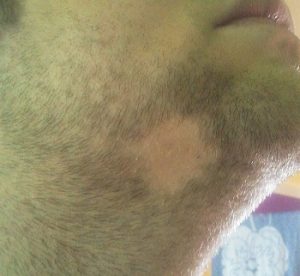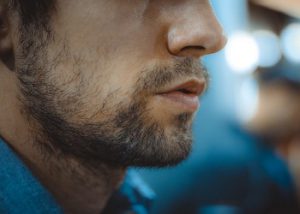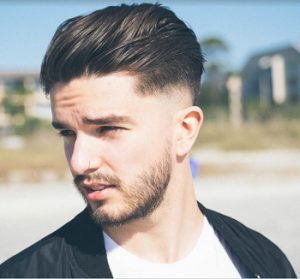
Alopecia areata or hair loss in patches not only affects the scalp, it can also affect the beard, eyebrows and moustache. It can be a devastating condition that causes many men to shave their beards off entirely.
There are many factors that could result in patchy beard loss and that is exactly the topic of today’s discussion. Let us study how you can grow out a patchy beard and different styles you might want to consider when having one.
What Causes Beard Loss?
There are many causes of alopecia areata. The word areata means ‘round’ while the word alopecia is Greek for ‘fox mange’. It was a term first coined by Hippocrates. Alopecia areata can affect anyone irrespective of age, gender and social class. In bearded men, it leads to small, round bald patches in the beard.
Dermatologists reason that the main cause of this condition is the immune system attacking itself in response to a certain stimulus. For example, a deficiency in some vital nutrients could lead to inadequate nutrition to the hair follicles causing them to fall out.
Another factor is hormonal disturbances in the body. A hormone called DHT or dihydrotestosterone impacts the hair follicles leading to inflammation. This also results in excess hair loss in the beard, scalp and other areas of the body. Stress increases certain hormones which contribute to DHT formation too. In any case, the result is hair fall in leading to a shabby patchy beard. Genetics and heredity also play a role.
Does The Hair Grow Back?
This is the main concern that men with patchy beards have. Sometimes the bald patches stay the same size but at other times, they might begin to grow again. Even if the hair grows back, it is temporary and starts to fall out again. In 30% of cases, the beard hair completely falls off. It may be accompanied by alopecia universalis where the person experiences hair-fall in all other areas of the body.
Conventional Treatment for Patchy Beard
The only two medicines available for alopecia today are Finasteride and Minoxidil. The former is an oral medicine available through prescription. However, it is supposed to have some serious side effects like sexual dysfunction etc.
The other, Minoxidil, is sold under brand name of Rogaine®. You can apply it topically in areas of hair loss but so far, it has only been approved for use on scalp. Many men have used it for fixing their patchy beard loss but the results have not been great. The reason for this is that you need to have hair follicles on the face where you apply this product. Secondly, the way Rogaine® works is that it first accelerates the hair fall only to later stimulate it. So you need to diligently use the product for at least 6 to 8 months to see results.
Furthermore, men who used Rogaine® to grow their facial hair have experienced headaches, dry skin, fatigue, overeating and many other adverse side effects.
So What Can One Do for Patchy Beards?
There are a number of things you can do to fix your patchy beard.
1. See a dermatologist
A dermatologist can do certain tests and take your complete medical history to ascertain if your beard loss is genetic, stress-related or caused by a nutritional deficiency. Based on these findings, s/he might suggest the next line of treatment which may include pills, topical solutions, and supplements to grow the beard out. If these do not show results, you may want to consider a beard transplant.
2. Follow a beard care home regime
In case you do not want to use expensive treatments described above, you must at least try to have a home beard care regime. This includes the use of a good beard shampoo followed by a beard conditioner. Also, use beard oils which nourish the hair follicles and stimulate hair growth. Try and exfoliate your skin weekly. Exfoliation helps remove dead skin and stimulates new growth. All these steps will keep your beard clean and healthy and prevent issues like fungal growth, dandruff and so on.
3. Rest and diet
You are what you eat and a good diet is the ideal beard bald spot filler. So make healthier food choices. Hair needs protein, vitamins and minerals so eat a balanced diet. If needed, take supplements. You can talk to your doctor about biotin, zinc and other minerals that hair needs for growth. Also, sleep for 8 hours each night to control stress.
4. Be patient
Sometimes, all your beard needs is time. Many men experience patchy growth when they first start growing one. The skin also becomes itchy at this stage. But patience goes a long way, so allow the beard time to grow completely. Do not shave it off just because you experience this discomfort. A slight trim can also help at this point. Continue using good quality beard oils to ward off itchiness and moisturize the hair and skin.
Styles for Patchy Beards
If your beard is patchy, then you might have limitations on the styles you choose. Select one of the following styles based on your features and shape of your face.
Stubble
This is the easiest to maintain. Keep the upper cheek and neck clean. Use a trimmer to maintain a consistent length of 3 to 5mm.
Goatee
This is a great patchy beard solution. Grow the hair under the bottom lip to a ½ inch then shape it. The extended goatee is another style.
Horseshoe
This is the Hulk Hogan beard and moustache characterized by two pipes going down the face. You need to clean shave the cheeks and can also opt to grow just the beard or only the moustache pipes.
Circle Beard
This is another great solution for men with patchy beard loss on cheeks. Shave the cheeks and neck and grow a goatee. Keep the length to 5mm and maintain a round shape for the beard.
Whether you have a bald spot under the chin or patchy beard growth progress; I hope the above tips and styles help you.





